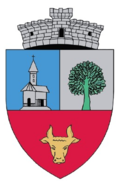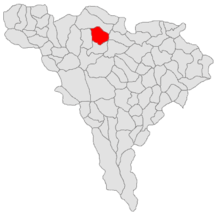Sălciua
|
Sălciua Sundorf Alsószolcsva |
||||
|
||||
| Basic data | ||||
|---|---|---|---|---|
| State : |
|
|||
| Historical region : | Transylvania | |||
| Circle : | Alba | |||
| Coordinates : | 46 ° 24 ' N , 23 ° 25' E | |||
| Time zone : | EET ( UTC +2) | |||
| Height : | 451 m | |||
| Area : | 75.26 km² | |||
| Residents : | 1,428 (October 20, 2011) | |||
| Population density : | 19 inhabitants per km² | |||
| Postal code : | 517645 | |||
| Telephone code : | (+40) 02 58 | |||
| License plate : | FROM | |||
| Structure and administration (as of 2016) | ||||
| Community type : | local community | |||
| Structure : | Sălciua, Dealu Caselor , Dumeşti , Sălciua de Jos , Sălciua de Sus , Sub Piatră , Valea Largă | |||
| Mayor : | Vasile Lombrea ( PNL ) | |||
| Postal address : | Str. Principală, no. 62 loc. Sălciua de Jos, jud.Alba, RO-517645 |
|||
| Others | ||||
| City Festival : | 8th of May; Cattle market (mainly sheep) | |||
Sălciua (outdated Sălciva-de-jos ; German Sundorf , Hungarian Alsószolcsva ) is a Romanian municipality in the Alba district in Transylvania . The seat of the municipality is Sălciua de Jos .
Geographical location
The municipality of Sălciua is located on Drum național 75 , on the left side of the Arieș River , southeast of the Muntele-Mare Mountains and northwest of the Trascău Mountains (Munții Trascăului) in Motzenland . The next town Baia de Arieș (Offenburg) is 15 kilometers to the west; the district capital Alba Iulia (Karlsburg) about 120 kilometers (38 km as the crow flies) to the southeast.
The small railway Turda – Abrud (93 kilometers) running through the town was put into operation in 1912 and closed in 1998.
history
The place Sălciua, one of the oldest Romanian hearing villages , was first mentioned in a document in 1379 or 1365 (according to different statements) under the name Zolchwa . It belonged to the Eisenburg domain in Torda-Aranyos County .
According to reports by G. Téglás from 1887 and M. Roska from 1941/1942, archaeological finds from the Early Bronze Age were made in the area of the municipality of Sălciua de Jos . According to JM Ackner (1856) and C. Gooss (1876), gold panning systems were operated on the Aries River in Roman times on the territory of the incorporated village of Sălciua de Sus .
The main occupations of the population are forestry, wood processing, animal husbandry and skinning .
population
The population has remained largely stable since it was first officially recorded in 1850. In 1850 there were 2567 inhabitants in the area of today's municipality; 2,512 of them were Romanians and 55 Roma . In 1890 the largest population - 2530 - and that of the Germans (14) - was registered. The highest number of Romanians (2,487) was recorded in 1956, Hungarians (36) in 1900 and Roma (66) in 1930. In addition, two residents identified themselves as Slovaks in 1910, two in 1966 and one in 1977 as Ukrainians . In 2002 there were still 1785 people living in the community (1780 Romanians, three Hungarians and two Roma).
Attractions
- The wooden church Sfânta Treime și Sfântul Prooroc Ilie in the incorporated village of Valea Largă , built in 1782, is a listed building.
- The wooden church Cuvioasa Paraschiva in the incorporated village of Sub Piatră , built in 1798, rebuilt in the 19th century and renovated in 2001, is a listed building.
- The village museum, in an old Motzenhaus (still under construction in 2009).
- The community is also the starting point for the Scărișoara-Belioara limestone massif , the Huda lui Papară stalactite cave and the Poarta Zmeilor cave (Dragon Gate ; 1100 m).
Web links
Individual evidence
- ↑ 2011 census in Romania ( MS Excel ; 1.3 MB)
- ↑ Mayoral elections 2016 in Romania ( MS Excel ; 256 kB)
- ^ Dictionary of the localities in Transylvania
- ↑ Video of the narrow-gauge railway between Turda and Abrud , on YouTube
- ↑ a b c Heinz Heltmann, Gustav Servatius (ed.): Travel Guide Siebenbürgen. Kraft-Verlag, Würzburg 1993, ISBN 3-8083-2019-2 , p. 138.
- ↑ Sălciua on www.sate-comune.ro, accessed May 16, 2010 ( Memento from August 21, 2009 in the Internet Archive )
- ^ Institute Of Archeology - Sălciua de Jos, accessed on May 16, 2010 (Romanian)
- ^ Institute Of Archeology - Sălciua de Sus, accessed on May 16, 2010 (Romanian)
- ↑ Census, last updated October 30, 2008, p. 151 (Hungarian; PDF; 1.2 MB)
- ↑ a b List of historical monuments of the Romanian Ministry of Culture, updated 2010 (PDF; 7.10 MB)







